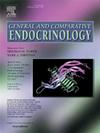重复使用外源激素会降低濒危蛙种(Litoria aurea)的精子数量和质量。
IF 1.7
3区 医学
Q3 ENDOCRINOLOGY & METABOLISM
引用次数: 0
摘要
辅助生殖技术对保护全球濒危两栖动物物种具有重要意义。这些技术可以克服两栖动物繁殖失败的问题,提高生殖生物学和生态学领域的濒危物种管理和研究质量。一种辅助生殖技术是使用外源性激素注射诱导精子。然而,反复使用外源激素对精子质量和数量的影响仍然知之甚少。在这项研究中,我们在濒危的澳大利亚蛙种Litoria aurea中反复施用外源性激素-人绒毛膜促性腺激素。我们分析了每两周、每一周和每两周给药3-4次的精子数量和质量(n = 6)。在每次给药后6小时内的三个时间点(注射后2、4和6小时)评估精子质量和数量。我们发现,通过降低精子浓度、体积、精子总数和活力,反复给药显著降低了精子数量和质量。通过多次给药,精子释放的时间发生了变化:仅一次给药后,精子在注射后2小时、4小时和6小时释放相同,而几次给药后,精子释放被推迟,以至于注射后6 h产生的精子数量和质量更高。总的来说,我们的研究结果表明,反复给雄性金冠乳杆菌激素会降低精子的数量和质量,并且个体在两次给药之间需要大量的时间来再生精子。本文章由计算机程序翻译,如有差异,请以英文原文为准。
Repeated exogenous hormone administration decreases sperm quantity and quality in threatened frog species (Litoria aurea)
Assisted reproductive technologies are important for protecting threatened amphibian species globally. These technologies can overcome amphibian breeding failure and improve threatened species management and research quality in the fields of reproductive biology and ecology. One assisted reproductive technology is inducing spermiation using exogenous hormone injections. However, the impacts of repeatedly administering exogenous hormones on sperm quality and quantity remain poorly understood. In this study we repeatedly administered an exogenous hormone — human chorionic gonadotropin — in the threatened Australian frog species, Litoria aurea. We analysed sperm quantity and quality over 3–4 hormonal administrations at biweekly, weekly, and fortnightly frequencies (n = 6 for each group). Sperm quality and quantity were assessed at three timepoints over a 6-hour period following each hormonal administration (hours 2, 4, and 6 post-injection). We found that repeated administrations significantly reduced sperm quantity and quality via reduced concentration, volume, total sperm counts, and viability. With repeated administrations, the timing of sperm release varied: after only one administration, sperm was released equivalently in hours 2, 4 and 6 post-injection, whereas after several administrations, sperm release was delayed such that 6 hr post-injection produced higher quantity and quality sperm. Overall, our results demonstrate that repeated hormonal administration of male L. aurea reduces sperm quantity and quality, and individuals will need substantial time to regenerate sperm between administrations.
求助全文
通过发布文献求助,成功后即可免费获取论文全文。
去求助
来源期刊

General and comparative endocrinology
医学-内分泌学与代谢
CiteScore
5.60
自引率
7.40%
发文量
120
审稿时长
2 months
期刊介绍:
General and Comparative Endocrinology publishes articles concerned with the many complexities of vertebrate and invertebrate endocrine systems at the sub-molecular, molecular, cellular and organismal levels of analysis.
 求助内容:
求助内容: 应助结果提醒方式:
应助结果提醒方式:


